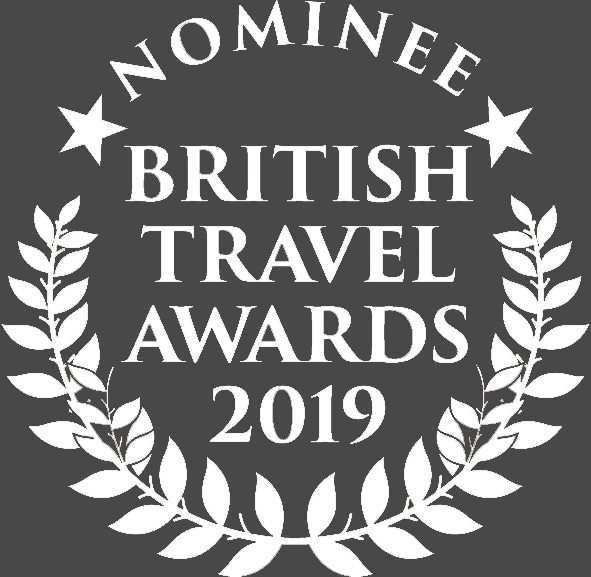Cambodia
All Destinations
Cambodia
Cambodia captivates travellers with its history, heritage, wealth of timeless monuments and charming people who are delighted to share their unique culture with its visitors.
Cambodia’s astonishing collection of ancient temples, some now hidden beneath creeping vines and impenetrable jungle, express the magnitude of its former glory. Pretty beaches, bustling towns and wild jungles are waiting to be discovered.
Centrally located along the Indochinese Peninsula and composed of an almost entirely levelled landscape, Cambodia’s geography has been instrumental in shaping both its history and its identity today. With the rise of the Khmer Empire, which flourished in Angkor for over 500 years and the country’s proximity to the turmoil of the Vietnam War, the country is now, thankfully recovering from a turbulent and tragic past.
Explore the resort town of Siem Reap in the northwest, gateway to the ruins of Angkor, a vast temple complex of intricate stone buildings including Angkor Wat, the main temple and the largest religious monument in the world. Enjoy Phnom Penh, Cambodia’s busy capital, sitting at the junction of the Mekong and Tonlé Sap rivers, a hub for both the Khmer Empire and French Colonialists.
Discover Battambang, an enchanting town on the Sangkae River known for colonial buildings such as Sala Khaet, the former Governor’s Residence and it’s Provincial Museum displaying artefacts from local Khmer temples. Venture into remote, rural villages, or the sparkling ocean that laps onto soft, white beaches along its immaculate coastline. A small number of idyllic hotels have opened in recent years to make it the perfect retreat after a busy exploration of this fascinating country.
Quick Facts
Capital
Phnom Penh
Population
16 million (UN, 2012)
Area
181,035 sq km (69,898 sq miles)
Major Languages
Khmer
Major religion
Buddhism
Monetary Unit
Riel
Flight time from London
14.5 hours via Bangkok
Time Difference
GMT + 7
When to go
The climate can generally be described as tropical. As the country is affected by monsoon, it is hot and humid with an average temperature of around 27.C (80.F). There are two distinct seasons: the Rainy Season and the Dry Season. However, the Dry Season is divided into two sub-seasons, cool and hot. These seasons are:
The Rainy season:
From June till October 27-35.C (80-95.f)
The Dry season (cool):
From November till February 17-27.C (80-95.F)
The Dry season (Hot) :
From March till May 29-38.C (84-100.F)
- J
- F
- M
- A
- M
- J
- J
- A
- S
- O
- N
- D
- High Season
- Mid Season
- Shoulder Season
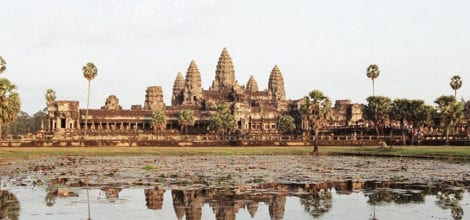
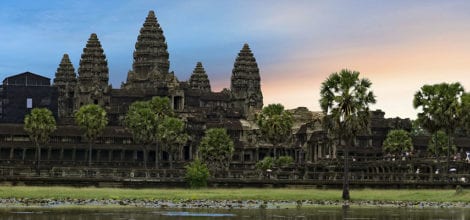

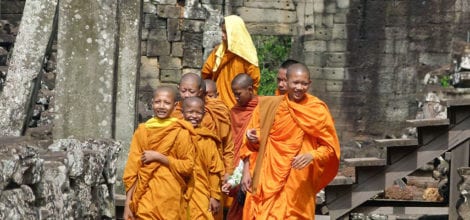

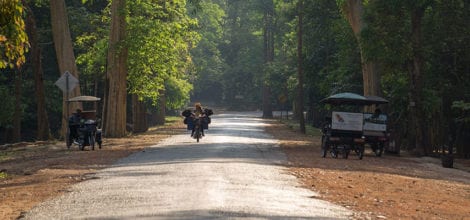
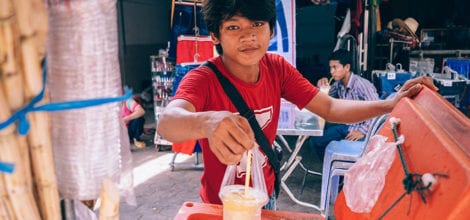

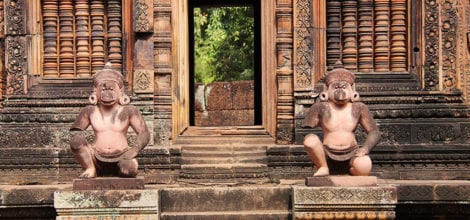
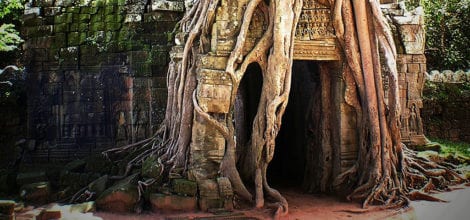

Siem Reap
Siem Reap province is located in northwest Cambodia. It is the major tourist hub in Cambodia, as it is the closest city to the world famous temples of Angkor (the Angkor temple complex is north of the city). The provincial capital is also called Siem Reap and is located in the South of the province on the shores of the Tonle Sap Lake, the greatest sweet water reserve in all of Southeast Asia. The name of the city literally means Siamese defeated, referring to the victory of the Khmer Empire over the army of the Thai kingdom in the 17th century.
At the turn of the millennium Siem Reap was a Cambodian provincial town with few facilities, minor surfaced roads and little in the way of nightlife. The tourism industry catered largely to hardy backpackers willing to brave the tortuous road from the Thai border on the tailgate of a local pick-up truck. There were a couple of large hotels and a handful of budget guesthouses. Tuk-tuks and taxis were non-existent and the trusty motodup was the chosen means of touring the temples of Angkor.
The proximity of the Angkorian ruins turned Siem Reap into a boomtown in less than half a decade. Large luxurious hotels have made themselves at home while property values have soared to European levels and tourism has become a vast, lucrative industry. The Siem Reap of today is barely recognizable from the Siem Reap of the year 2000.
Though some of the town’s previous ramshackle charm may have been lost the developments of the last few years have brought livelihoods, if not significant wealth, to a good number of its citizens. Despite the massive shift in its economic fortunes, Siem Reap remains a safe, friendly and pleasant town. There is an endless choice of places to stay or dine and a host of possible activities awaiting the visitor.

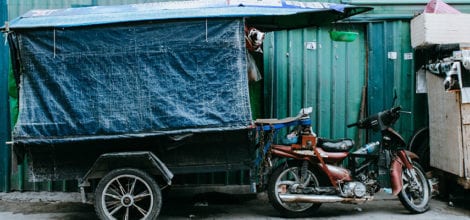

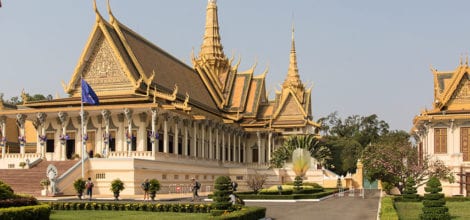
Phnom Penh
Phnom Penh is the vibrant bustling capital of Cambodia. Situated at the confluence of three rivers, the mighty Mekong, the Bassac and the great Tonle Sap, what was once considered the ‘Gem’ of Indochina. The capital city still maintains considerable charm with plenty to see. It exudes a sort of provincial charm and tranquillity with French colonial mansions and tree-lined boulevards amidst monumental Angkorian architecture. Phnom Penh is a veritable oasis compared to the modernity of other Asian capitals. A mixture of Asian exotica, the famous Cambodian hospitality awaits the visitors to the capital of the Kingdom of Cambodia.
Here in the capital, are many interesting sites that explain more about the country’s culture and history. Beside the Royal Palace, the Silver Pagoda, the National Museum, the Toul Sleng Genocide Museum, the Choeng Ek Killing Fields and Wat Phnom, there are several market places selling carvings, paintings, silk, silver, gems and even antiques. Indeed, an ideal destination for a leisurely day tour. The whole area including the outskirts of Phnom Penh is about 376 square kilometres big. There are currently 2,009,264 people living in Phnom Penh.
The city takes its name from the re-known Wat Phnom Daun Penh (nowadays: Wat Phnom or Hill Temple), which was built in 1373 to house five statues of Buddha on a man made hill 27 meters high. These five statues were floating down the Mekong in a Koki tree and an old wealthy widow named Daun Penh (Grandma Penh) saved them and set them up on this very hill for worshiping. Phnom Penh was also previously known as Krong Chaktomuk (Chaturmukha) meaning “City of Four Faces”. This name refers to the confluence where the Mekong, Bassac, and Tonle Sap rivers cross to form an “X” where the capital is situated.
Phnom Penh is also the gateway to an exotic land – the world heritage site, the largest religious complex in the world, the temples of Angkor in the west, the beaches of the southern coast and the ethnic minorities of the North-eastern provinces. There are also a wide variety of services including five star hotels and budget guest houses, fine international dining, sidewalk noodle shops, neighbourhood pubs international discos and more.
Phnom Penh, like other Asian cities, is in the midst of rapid change. Over the past few years the number of restaurants and hotels have grown considerably bringing a significant increase in the number of visitors.
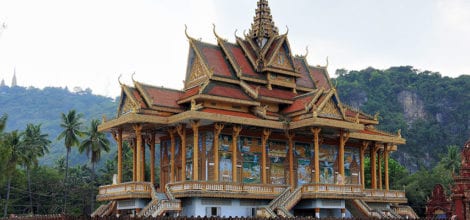
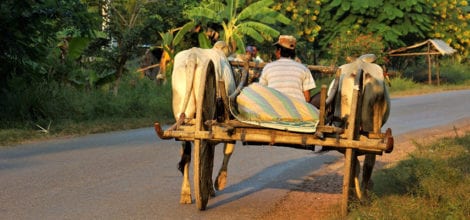
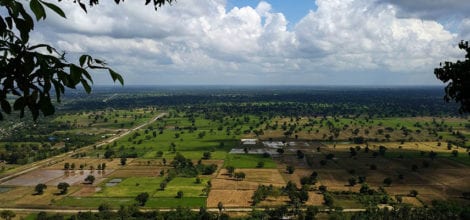
Battambang
Battambang is Cambodia’s second-largest city and the capital of Battambang Province, which was founded in the 11th century. It is the former capital of Monton Kmer and lies in the heart of the Northwest of Cambodia. Until the war years, in which almost every infrastructure was destructed it was the leading rice-producing province of the country.
The name Battambang or Batdambang, literally means “loss of stick” referring to a legend of the Preah Bat Dambang Kranhoung (Kranhoung Stick King). The population is nowadays around 250,000 people . It’s a riverside town, home to some of the best-preserved, French colonial architecture in the country.
Until recently Battambang was off the map for road travellers, but facilities have recently been improved and it makes a great base for visiting the nearby temples, such as Phnom Banon and Wat Ek Phnom, as well as the closedby villages.
It’s a secondary hub on the overland route between Thailand and Vietnam, and if the National Highway No 6 from Poipet to Siem Reap is ever upgraded it’ll become an even smaller hub. The network of charming old French shop houses clustered along the riverbank is the real highlight here, and there are a number of Wats scattered around the town.
The small museum has a collection of Angkorian-era artifacts, and beyond the town there’s a number of hilltop temples, yet more Wats and a pretty large lake. One of the more famous hills is Phnom Sampeau (Ship Hill) with the notorious killing caves.
Battambang did not give way to the Khmer Rouge movement after the fall of Phnom Penh, but it?s been in the centre of the ongoing government Khmer Rouge conflict ever since the Vietnamese invasion in 1979 pushed the genocidal regime out of Phnom Penh and to the Northwest. Until the surrender deal of Ieng Sary (Khmer Rouge number three man based in Pailin),Battambang was the Khmer Rouge stronghold in the region.
In the earlier history Battambang flip-flopped back and forth between Thailand (called Siam before their 20th-century renaming) and Cambodia. It’s been a part of Thailand most of the time since the 15th century, with Cambodia regaining control (more specifically due the French) in 1907. The Thais grabbed it again, with Japanese assistance, in 1941 and kept the region in their camp until the World War II years in 1947.
The Allied Forces helped persuade the Thais that the region was originally part of ancient Cambodia and the world community would not take kindly to the Thais holding onto it further. Like the rest of the Northwest, there is still a lot of Thai influence apparent. The main currency is still the Thai Baht and many people are able to converse in Thai. But the area is very Khmer, with ancient Khmer ruins scattered around, and even the ways of life are much more similar to the rest of Cambodia than to Thailand.
Battambang city is a peaceful and pleasant place these days. The main parts of the city are situated closed to the Sangker River, a tranquil, small body of water that winds its way through Battambang Province. It is a nice, picturesque setting. As with much of Cambodia, the French architecture is an attractive bonus of the city.
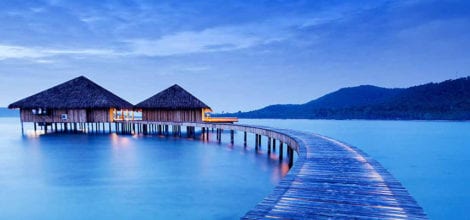
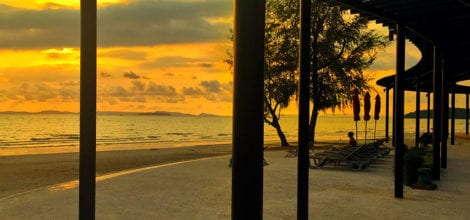
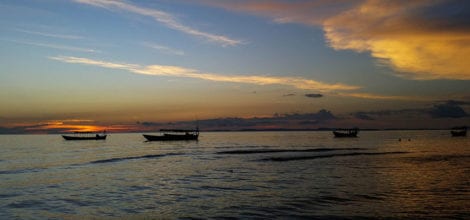
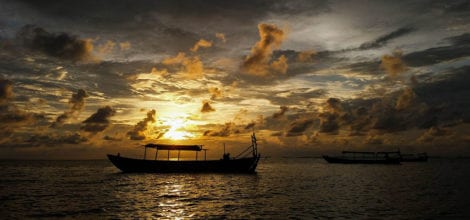

Coastal Cambodia
Fringed by enchanting historical towns and picturesque fishing villages, Cambodia’s coastline is touched by the tepid crystals waters of the Gulf of Thailand. The delightful lack of built up resorts along the coastline is a refreshing change from many other countries in the same region and as it is still to develop as a destination for mass tourism, it exists today, in all its raw beauty. After soaking up the country’s history and culture, untouched rainforests and picture perfect beaches act as a glorious contrast and ideal spot to put ones feet up and recharge.
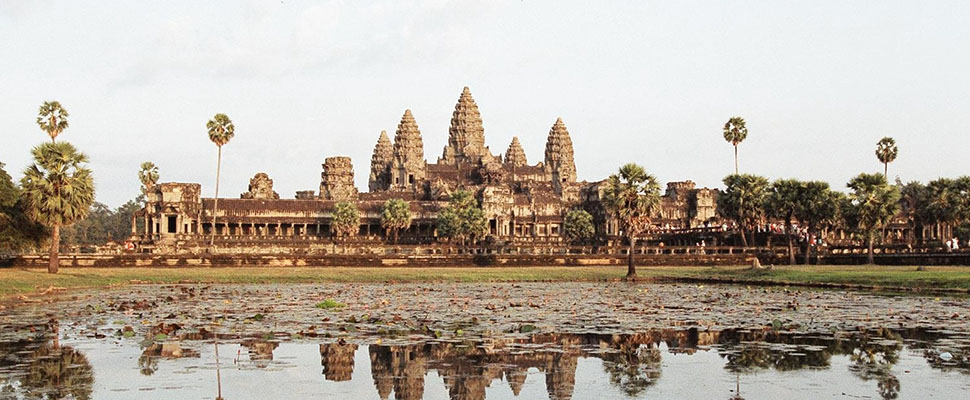

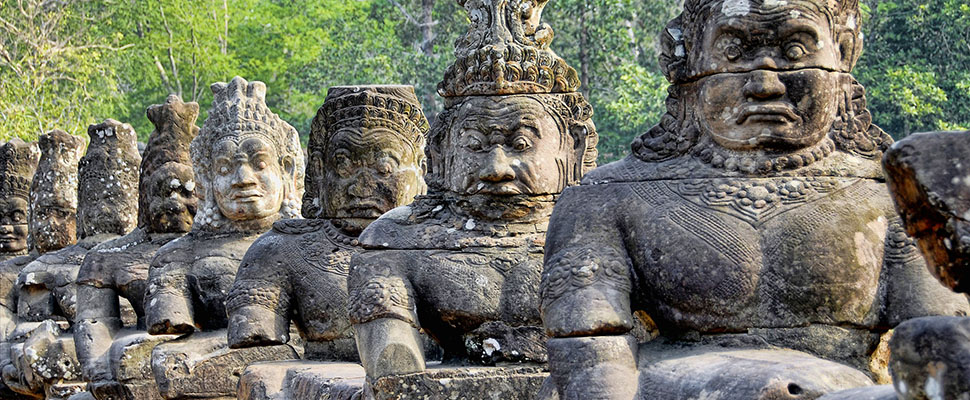

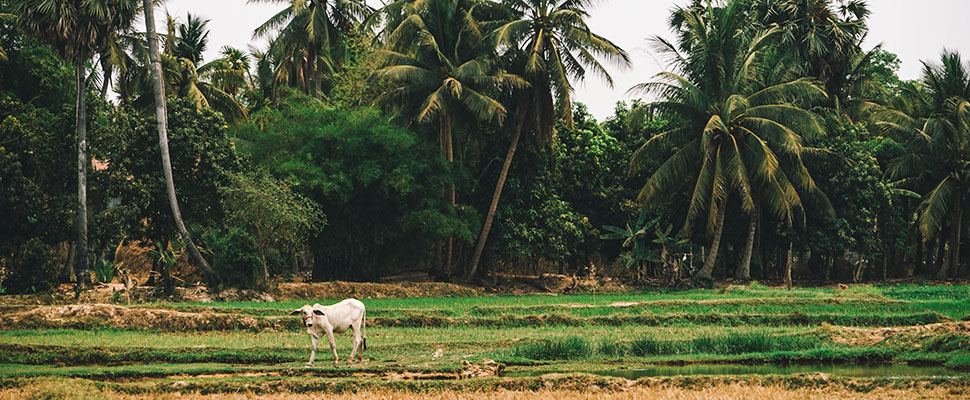
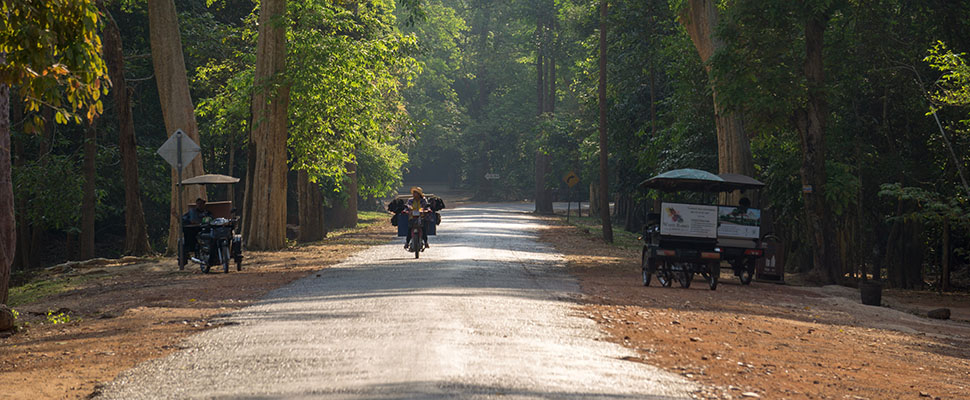
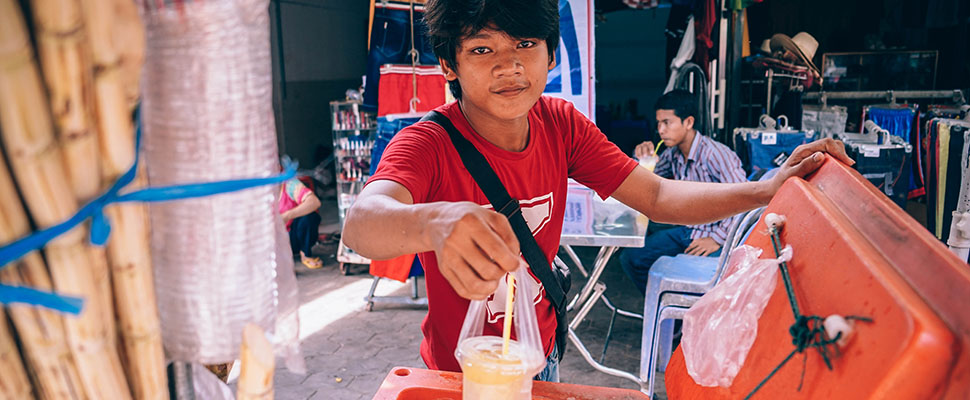
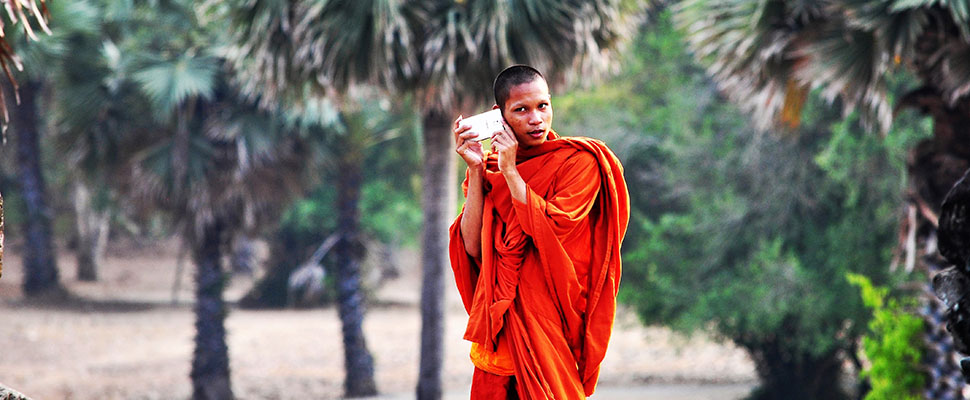
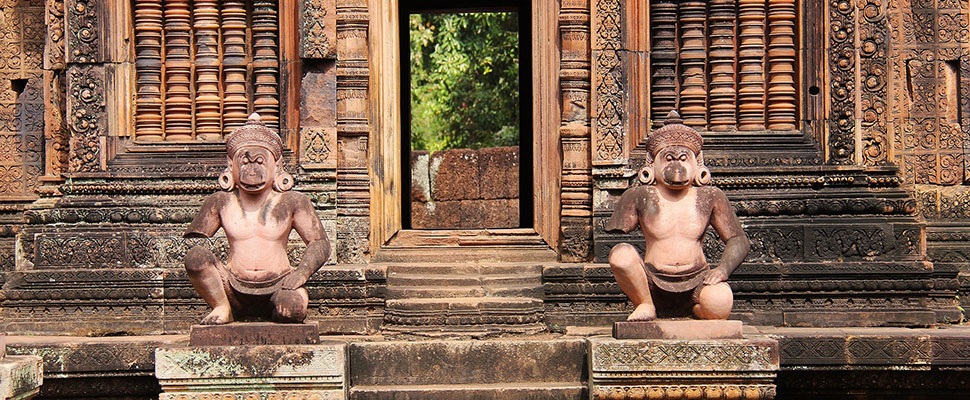
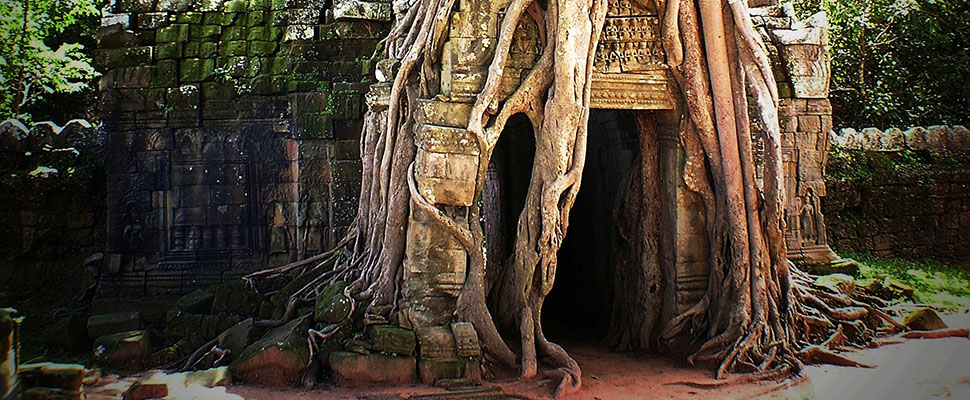
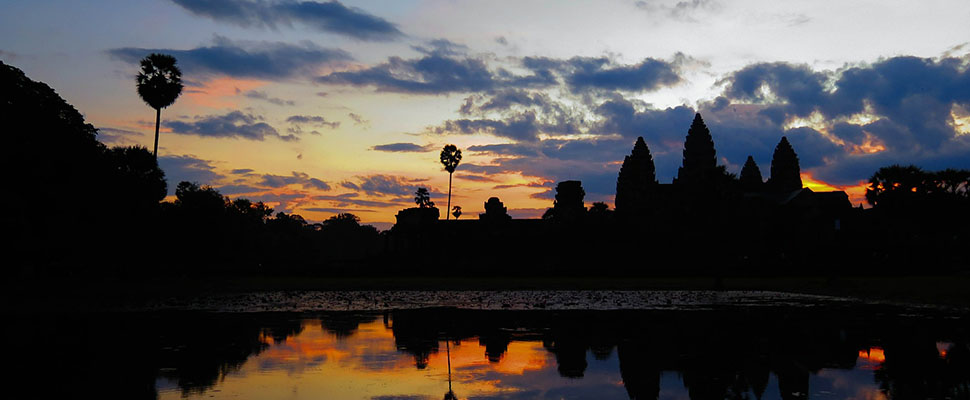
Siem Reap
Siem Reap province is located in northwest Cambodia. It is the major tourist hub in Cambodia, as it is the closest city to the world famous temples of Angkor (the Angkor temple complex is north of the city). The provincial capital is also called Siem Reap and is located in the South of the province on the shores of the Tonle Sap Lake, the greatest sweet water reserve in all of Southeast Asia. The name of the city literally means Siamese defeated, referring to the victory of the Khmer Empire over the army of the Thai kingdom in the 17th century.
At the turn of the millennium Siem Reap was a Cambodian provincial town with few facilities, minor surfaced roads and little in the way of nightlife. The tourism industry catered largely to hardy backpackers willing to brave the tortuous road from the Thai border on the tailgate of a local pick-up truck. There were a couple of large hotels and a handful of budget guesthouses. Tuk-tuks and taxis were non-existent and the trusty motodup was the chosen means of touring the temples of Angkor.
The proximity of the Angkorian ruins turned Siem Reap into a boomtown in less than half a decade. Large luxurious hotels have made themselves at home while property values have soared to European levels and tourism has become a vast, lucrative industry. The Siem Reap of today is barely recognizable from the Siem Reap of the year 2000.
Though some of the town’s previous ramshackle charm may have been lost the developments of the last few years have brought livelihoods, if not significant wealth, to a good number of its citizens. Despite the massive shift in its economic fortunes, Siem Reap remains a safe, friendly and pleasant town. There is an endless choice of places to stay or dine and a host of possible activities awaiting the visitor.
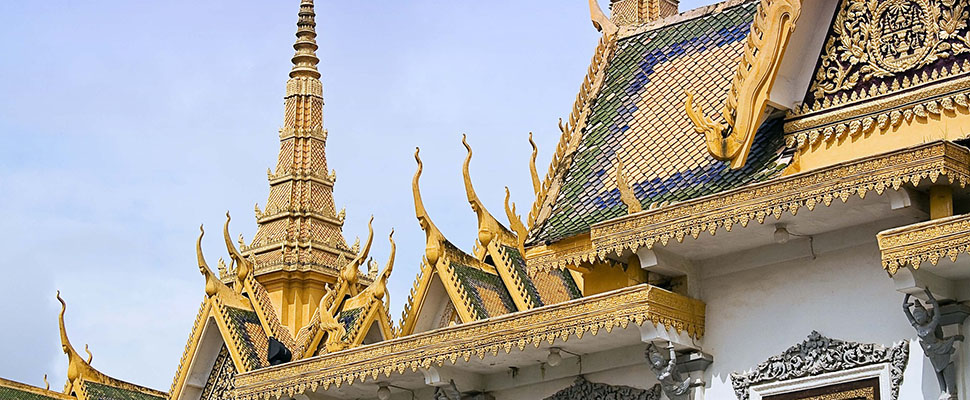
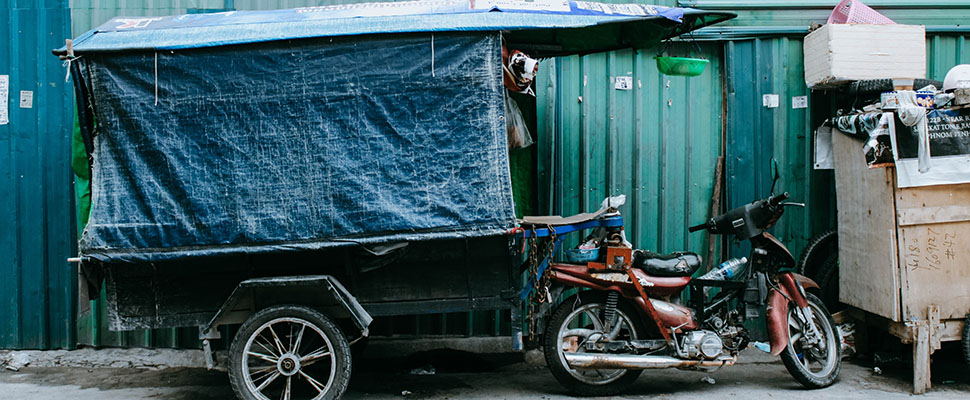

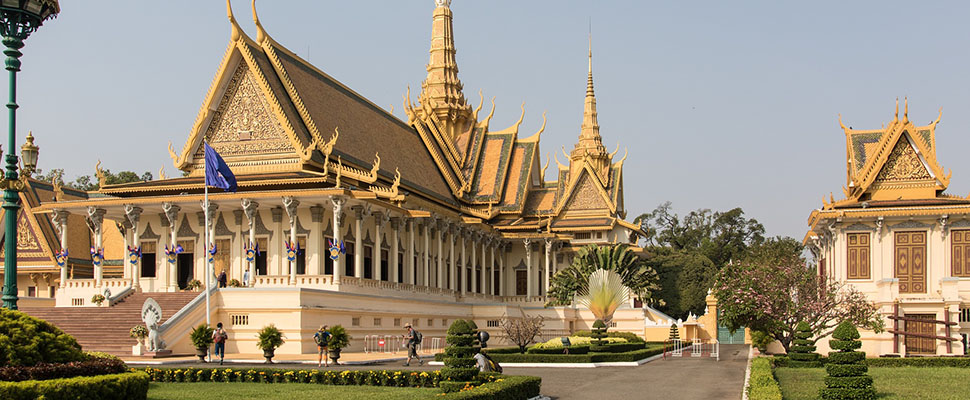
Phnom Penh
Phnom Penh is the vibrant bustling capital of Cambodia. Situated at the confluence of three rivers, the mighty Mekong, the Bassac and the great Tonle Sap, what was once considered the ‘Gem’ of Indochina. The capital city still maintains considerable charm with plenty to see. It exudes a sort of provincial charm and tranquillity with French colonial mansions and tree-lined boulevards amidst monumental Angkorian architecture. Phnom Penh is a veritable oasis compared to the modernity of other Asian capitals. A mixture of Asian exotica, the famous Cambodian hospitality awaits the visitors to the capital of the Kingdom of Cambodia.
Here in the capital, are many interesting sites that explain more about the country’s culture and history. Beside the Royal Palace, the Silver Pagoda, the National Museum, the Toul Sleng Genocide Museum, the Choeng Ek Killing Fields and Wat Phnom, there are several market places selling carvings, paintings, silk, silver, gems and even antiques. Indeed, an ideal destination for a leisurely day tour. The whole area including the outskirts of Phnom Penh is about 376 square kilometres big. There are currently 2,009,264 people living in Phnom Penh.
The city takes its name from the re-known Wat Phnom Daun Penh (nowadays: Wat Phnom or Hill Temple), which was built in 1373 to house five statues of Buddha on a man made hill 27 meters high. These five statues were floating down the Mekong in a Koki tree and an old wealthy widow named Daun Penh (Grandma Penh) saved them and set them up on this very hill for worshiping. Phnom Penh was also previously known as Krong Chaktomuk (Chaturmukha) meaning “City of Four Faces”. This name refers to the confluence where the Mekong, Bassac, and Tonle Sap rivers cross to form an “X” where the capital is situated.
Phnom Penh is also the gateway to an exotic land – the world heritage site, the largest religious complex in the world, the temples of Angkor in the west, the beaches of the southern coast and the ethnic minorities of the North-eastern provinces. There are also a wide variety of services including five star hotels and budget guest houses, fine international dining, sidewalk noodle shops, neighbourhood pubs international discos and more.
Phnom Penh, like other Asian cities, is in the midst of rapid change. Over the past few years the number of restaurants and hotels have grown considerably bringing a significant increase in the number of visitors.
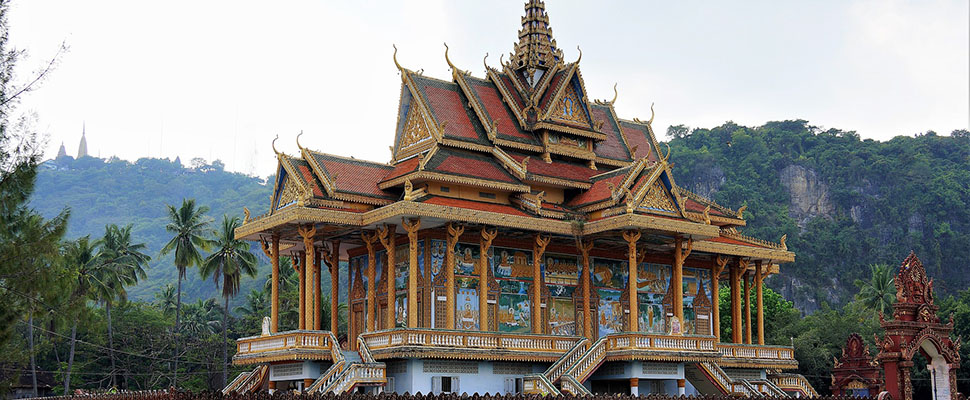
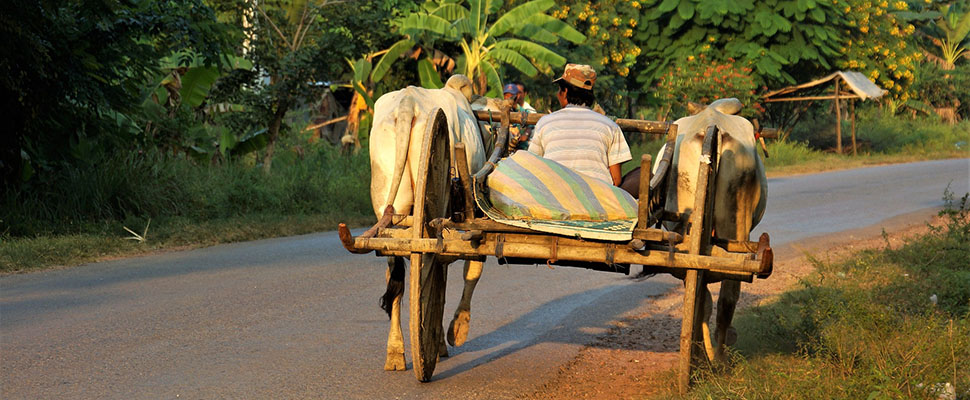

Battambang
Battambang is Cambodia’s second-largest city and the capital of Battambang Province, which was founded in the 11th century. It is the former capital of Monton Kmer and lies in the heart of the Northwest of Cambodia. Until the war years, in which almost every infrastructure was destructed it was the leading rice-producing province of the country.
The name Battambang or Batdambang, literally means “loss of stick” referring to a legend of the Preah Bat Dambang Kranhoung (Kranhoung Stick King). The population is nowadays around 250,000 people . It’s a riverside town, home to some of the best-preserved, French colonial architecture in the country.
Until recently Battambang was off the map for road travellers, but facilities have recently been improved and it makes a great base for visiting the nearby temples, such as Phnom Banon and Wat Ek Phnom, as well as the closedby villages.
It’s a secondary hub on the overland route between Thailand and Vietnam, and if the National Highway No 6 from Poipet to Siem Reap is ever upgraded it’ll become an even smaller hub. The network of charming old French shop houses clustered along the riverbank is the real highlight here, and there are a number of Wats scattered around the town.
The small museum has a collection of Angkorian-era artifacts, and beyond the town there’s a number of hilltop temples, yet more Wats and a pretty large lake. One of the more famous hills is Phnom Sampeau (Ship Hill) with the notorious killing caves.
Battambang did not give way to the Khmer Rouge movement after the fall of Phnom Penh, but it?s been in the centre of the ongoing government Khmer Rouge conflict ever since the Vietnamese invasion in 1979 pushed the genocidal regime out of Phnom Penh and to the Northwest. Until the surrender deal of Ieng Sary (Khmer Rouge number three man based in Pailin),Battambang was the Khmer Rouge stronghold in the region.
In the earlier history Battambang flip-flopped back and forth between Thailand (called Siam before their 20th-century renaming) and Cambodia. It’s been a part of Thailand most of the time since the 15th century, with Cambodia regaining control (more specifically due the French) in 1907. The Thais grabbed it again, with Japanese assistance, in 1941 and kept the region in their camp until the World War II years in 1947.
The Allied Forces helped persuade the Thais that the region was originally part of ancient Cambodia and the world community would not take kindly to the Thais holding onto it further. Like the rest of the Northwest, there is still a lot of Thai influence apparent. The main currency is still the Thai Baht and many people are able to converse in Thai. But the area is very Khmer, with ancient Khmer ruins scattered around, and even the ways of life are much more similar to the rest of Cambodia than to Thailand.
Battambang city is a peaceful and pleasant place these days. The main parts of the city are situated closed to the Sangker River, a tranquil, small body of water that winds its way through Battambang Province. It is a nice, picturesque setting. As with much of Cambodia, the French architecture is an attractive bonus of the city.
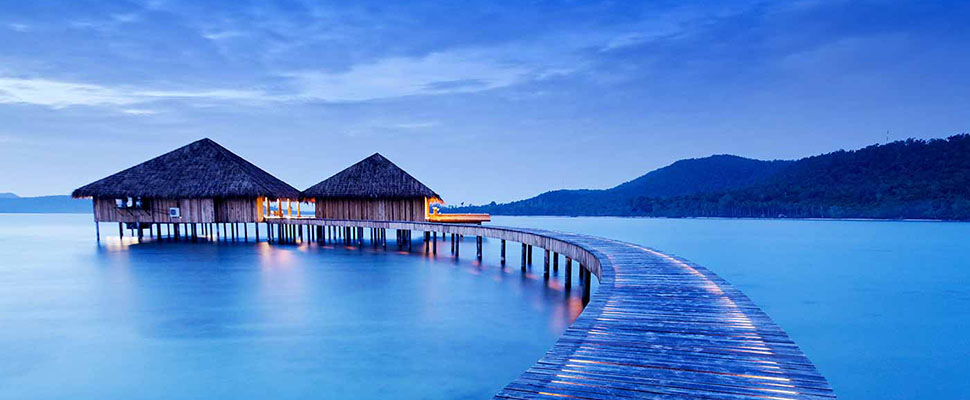


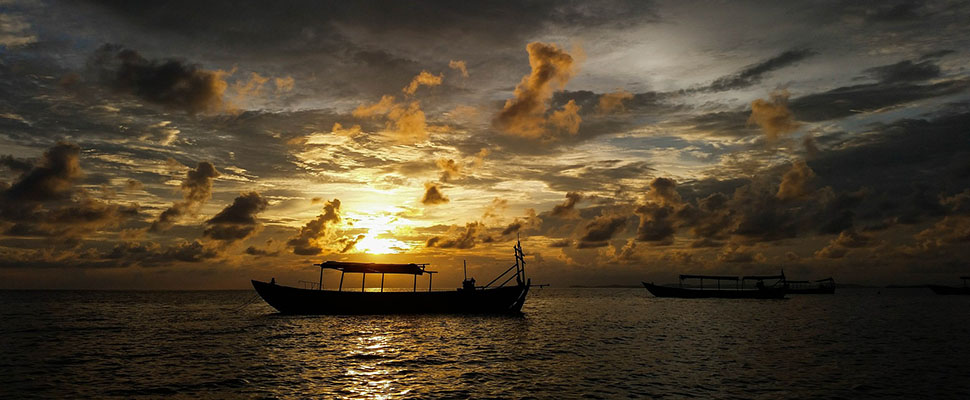
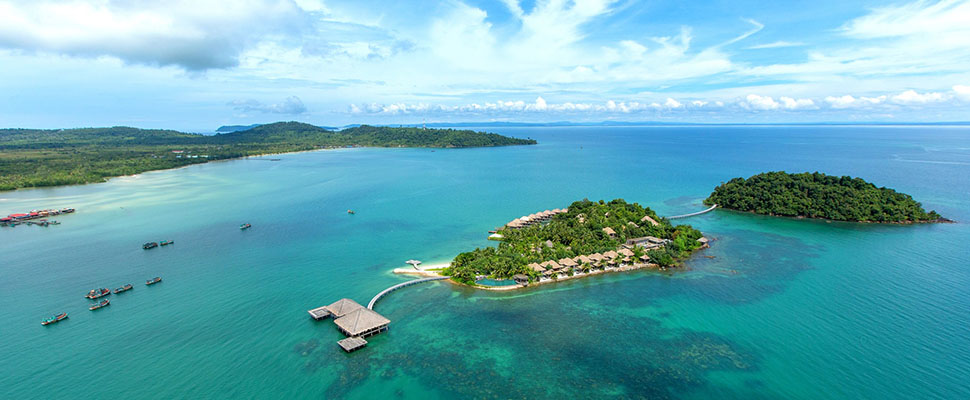
Coastal Cambodia
Fringed by enchanting historical towns and picturesque fishing villages, Cambodia’s coastline is touched by the tepid crystals waters of the Gulf of Thailand. The delightful lack of built up resorts along the coastline is a refreshing change from many other countries in the same region and as it is still to develop as a destination for mass tourism, it exists today, in all its raw beauty. After soaking up the country’s history and culture, untouched rainforests and picture perfect beaches act as a glorious contrast and ideal spot to put ones feet up and recharge.
Where to stay
These are just a selection of the properties we can personally recommend. Please get in touch to hear more about our full portfolio.
4 Rivers Floating Lodge
4 Rivers Floating Lodge is set on the mighty Tatai River with a backdrop of the Cardamom Mountains in South West Cambodia. This unique ecolodge is an ideal getaway for those looking to explore Cambodia’s pristine wilderness in comfort and style.
Alila Villas Koh Russey
Alila Villas is located in Koh Russey, Southern Cambodia and offer a luxurious and modern haven for those visiting the region. The resort has a fantastic spa, luxurious and well-designed villa accommodation and excellent dining choices.
Amansara
Situated on the outskirts of vibrant Siem Reap, just 10 minutes from the Unesco World Heritage Site of Angkor Archaeological Park, Amansara is a masterpiece of 1960s New Khmer architecture – an unabashedly modern style.
Knai Bang Chatt
Unique Knai Bang Chatt is a chic boutique hotel situated in the quaint fishing village of Kep, a beach destination on Cambodia’s South Coast, once the 1960s escape for the elite.
Phum Baitang
Phum Baitang, which means ‘Green village’, is a 5-star luxury hotel on the outskirts of Siem Reap. Set within 20 acres of lush gardens, lemon-grass meadows and rice paddies, this elegant retreat is ideally located just 10 minutes from the majesty of Angkor Wat.
Raffles Hotel Le Royal
An historic Landmark reinterpreted in a bold contemporary style. Raffles Hotel Le Royal is a place where an elegant past lives on in the vibrant, trendy present – just like the city you will explore from this comfortable haven of calm.
Shinta Mani Wild
Shinta Mani Wild is a radical new fusion of world-class design, hospitality and conservation. The camp was born when world-renowned designer Bill Bensley identified an unprotected, 350-hectare wildlife corridor – and set out to save it from poaching, mining and logging.
Six Senses Krabey Island
An idyllic 30-acre private island is the setting for Six Senses Krabey which embraces just 40 pool villas set in a lush jungle landscape with a rocky coastline, fringed by a boardwalk that is a glorious fusion of land and water.
Song Saa
Spanning two discreet islands, the resort known locally as Song Saa – a Khmer name meaning “the sweethearts” is as intimate and seductive as the name implies.
Get in touch with us now to start planning your journey
Follow Us
Proudly ASSOCIATED WITH






